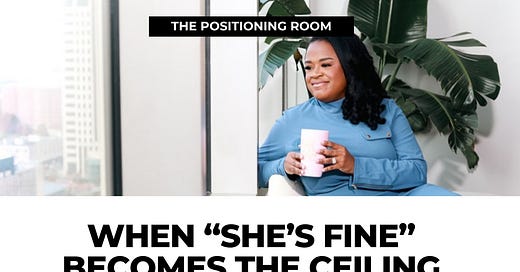When “She’s Fine” Becomes the Ceiling
A lens to help you name what your steadiness is costing you + how to fix it
There’s a quiet assumption that follows competent women into leadership.
She’s got it. She’s good. She’s fine.
It’s often said with admiration.
But what’s rarely acknowledged is the ceiling that gets built around it.
Because the moment “she’s fine” becomes the story, two things happen:
The urgency to consider what she wants disappears
The pressure to hold what others drop increases
She becomes the load carrier.
The one who absorbs tension without reaction.
The one who can be trusted to manage things, even when no one else wants to.
And eventually, the role she holds becomes less about how she leads and more about how much she can carry without flinching.
This is where positioning gets blurry.
Not because she’s unclear. But because her steadiness has been interpreted as capacity and her capacity, over time, gets mistaken for her ceiling.
So she’s not excluded. She’s just not considered.
She’s not unseen. She’s just filtered through a lens that makes her feel too… handled to promote, too steady to pull into something messier, too dependable to disrupt.
And what once felt like trust now starts to feel like quiet bypassing.
This isn’t about performing distress or becoming less capable. It’s about naming the cost of being read as perpetually steady and whether that’s positioning you or protecting the room.
This is what I call The Stability Tax.
It’s not in your job description.
But it shows up in your calendar, your body, your inbox, and your opportunities.
And most women don’t realize they’ve been paying it until their influence plateaus.
And in a market like this, women who’ve made themselves indispensable often become immovable.
🧩 The Stability Tax Audit™
Use these four prompts to surface where “I’m fine” has been assigned to you and how it may be quietly capping your mobility.
1. Where am I being relied on more than I’m being considered?
Think roles, projects, org shifts. Who counts on you to execute? Who’s involving you in future decisions?
2. Where is my silence being interpreted as agreement or capacity?
Not speaking up isn’t always strategic. Sometimes it teaches the room that nothing needs to change.
3. Where has my steadiness led people to assume I don’t need support, context, or credit?
This is where emotional labor turns into invisible labor. Track it.
4. Where am I being kept in place by what I’ve made look easy?
What have you done so well, for so long, that people can’t imagine you not doing it?
You don’t need to act on these yet.
Just name them. Because what remains unnamed stays unconfronted.
This space is where we interrupt that.
This is the kind of strategic clarity we build here every week.
But if you’re ready to start applying this in high-stakes moments to shift how you’re read, reposition your presence, and move with more precision
That’s the work we do inside Positioned for More™.
It’s where strategy turns into structure, language, and movement built around your real context.
Where we stop internalizing the weight of being the “calm one,” the “capable one,” the “good one” as if it’s the full story.
You can be strategic and stretched. Centered and still capped.
The power is in knowing what role the room has cast you in so you can start choosing your position, instead of reinforcing their perception.
That’s what we’re here for.
More soon,
Alicia



